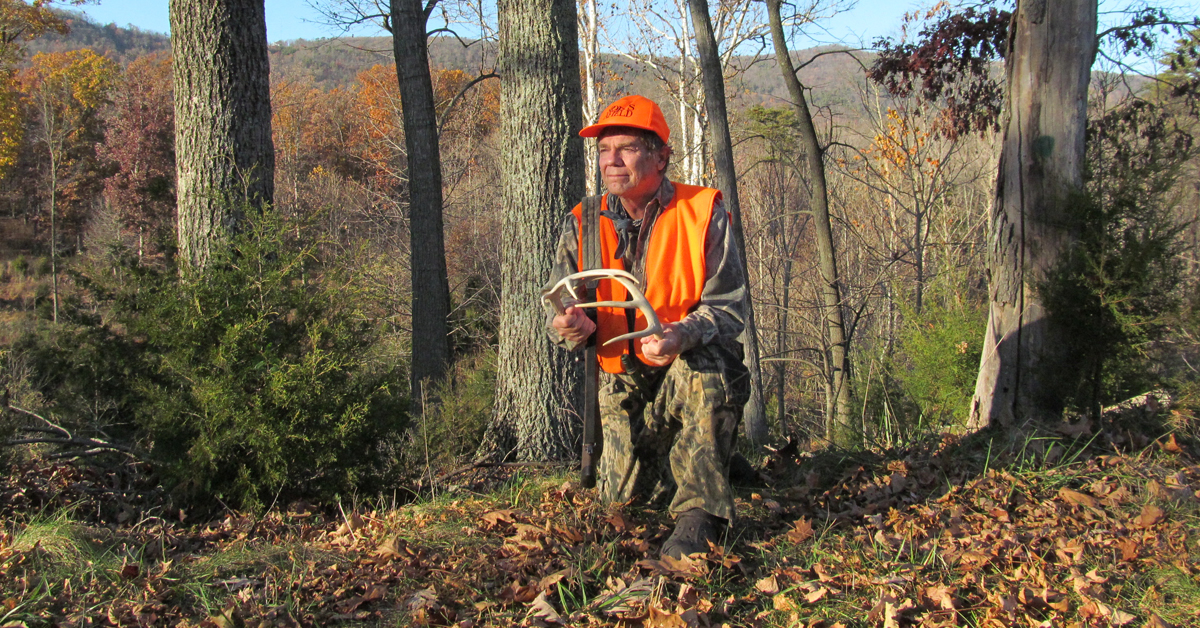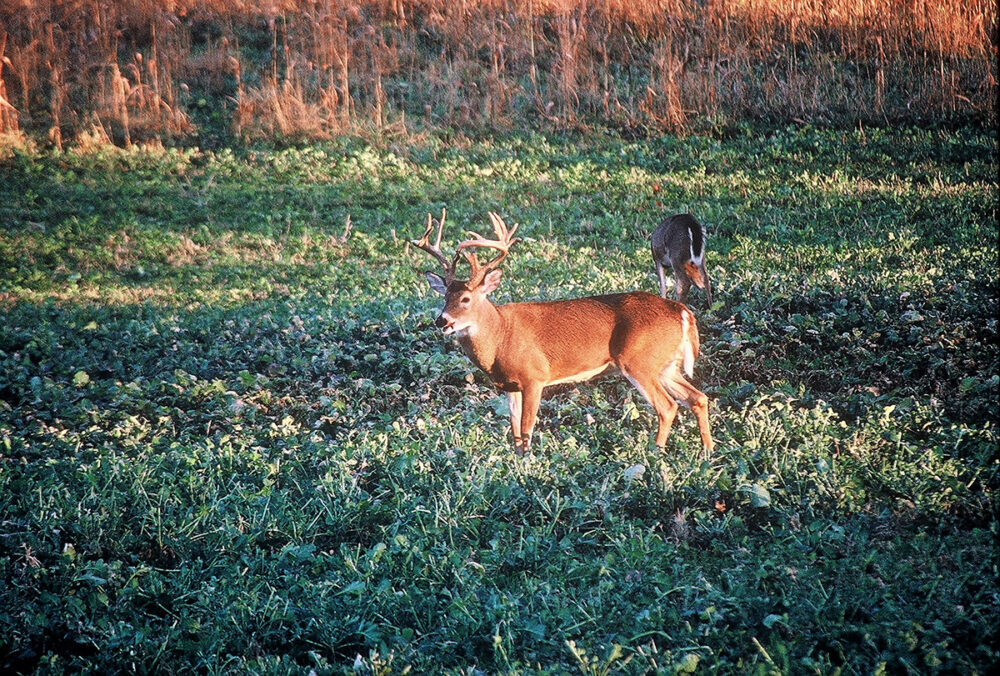
By Gerald Almy
Photos by Gerald Almy
Bone-hard antlers crash, clatter and grind together. Hooves pound the dirt, kicking up a spray of brown soil. Blackberry and honeysuckle bushes thrash in a frenzy. It’s an all-out buck fight.
Only in this case, you created the battle sounds by clashing antlers together, pounding the ground, and raking brush.
Get your bow or gun ready. Within minutes, a buck may come sneaking in or racing at an all-out gallop to check out the commotion.
Of all the many ways to hunt whitetail deer, none gets the adrenaline pumping like rattling. And few tactics are more effective in the right situation—meaning when a testosterone-charged buck at least 2 years or older is nearby and itching for a fight.
Just ask James McMurray, of Louisiana. The first time he rattled he shot a 281 6/8 net non-typical Boone & Crockett buck—on public land.
Native Americans used rattling to call in deer, but the technique first caught on among modern hunters in south Texas. It is extremely popular there, but hunters have learned that this technique will also draw in deer in all regions where whitetails are found—including Virginia!
Rattling draws in some bucks bristling for a fight. Others seem more interested in sneaking off with the estrous doe that they believe caused the battle. A few appear to come in simply from curiosity, particularly young bucks.
Some slip in warily. Others rush in at a full gallop. Be prepared for both outcomes.
Where & When to Rattle
Before delving into rattling strategy and technique, it’s important to consider where and when the tactic is most likely to work best in Virginia.
As a rule, areas with light hunting pressure are best. Deer in heavily hunted areas are often too skittish and edgy to come to horns. Finding escape cover is what’s on their minds.
That means two types of areas can produce—remote public lands or light- to moderately hunted private property. Public lands can offer good rattling if you are willing to hike in a mile or two from roads where the deer are lightly pressured. Private lands with limited hunting are also ideal.
Areas with a reasonable buck-to-doe ratio—not heavily tilted towards does—are also most likely to produce positive rattling results. (That’s another reason to keep female deer populations in check.)
Finally, locations with a good number of mature bucks are preferred. Deer 3 years old and up are most likely to respond to calling.

Mature bucks are the most likely to respond to rattling.
Tactics
Bucks approach the sound of rattling most often from downwind. Set up where you have a good viewing area for 50 to 100 yards in that direction, but also some cover such as brush or cedars so the deer don’t see you.
Prime areas to rattle include oak flats or broken fields with scrub pines, cedar, blackberry, honeysuckle, or other low brush scattered about. Find these near semi-open doe family bedding and feeding areas, where bucks will be concentrated as the rut approaches.
Choose areas with abundant fresh sign such as scrapes, licking branches, rubs, and large tracks. Avoid areas too open, since bucks might feel vulnerable and be wary of coming in. On the other hand, don’t select locations with such thick cover that you can’t see more than 20 yards, either.
Setting up with a partner is often best. Position the shooter 5 to 25 yards downwind of the rattler, depending on thickness of the cover.
This solves one of the main problems found with the tactic. In a study conducted by biologist Mickey Hellickson, hunters couldn’t see 57 percent of the bucks that came to the sound of the rattling horns. The bucks approached the sound, but remained hidden back in cover.
Use real antlers if you have them, but synthetic versions also work. You can make a pair of rattling antlers easily from the headgear of a buck you previously harvested or sheds you found. They don’t have to be a matching pair, just similar sizes.
When using a harvested buck, saw off both sides of the antler at the base of the skull, then cut off or smooth down the brow tines. Attach a lanyard around the bases and you have a workable set of rattling antlers. For extra safety, some hunters paint their antlers blaze orange.
Rattling bags, boxes, and shakers are also available in a variety of formats. All will produce a credible buck fight sound. Their main advantage is that you can use them with one hand and minimal movement, then surreptitiously drop them at your side if a buck sneaks in on you. That’s not so easy with a full-sized pair of antlers.
If you suspect a buck might be very close, try a light, low-key sequence initially. Often early in the season bucks will lightly spar and won’t make a racket. Once you’ve given nearby deer a chance to appear, switch to louder sounds to attract bucks from longer distances. Field studies have shown that loud rattling entices bucks best of all.
Making Noise
Clack the two halves of the rack together hard once to begin the sequence, like two bucks initially making contact. After that, twist them to create a realistic grinding sound. Bucks actually do more of this during a fight than banging their antlers together.
Follow that with lots of short wrist-turning and light clattering to make that distinctive “rattling” sound.
Pause after 30-60 seconds or so to pound the ground with the antlers. Also thrash and rake the bushes around you for added realism, like bucks attacking trees to intimidate their opponent or being shoved into the brush. In many cases throwing in a few buck grunts or bleats can help entice the quarry into range.
Rattle for one to three minutes and then pause for 10-15 minutes. Rattle again. If nothing comes after the second sequence, you can try a third time. But it’s generally better to move to a fresh area.
Rattling (and grunting) can also be done from a tree stand. If you’re using that approach, wait a half hour if you’re on stand, then try a rattling sequence again.
When to use: Mornings are best for rattling, evenings second best. You can rattle a buck in at any time of day, though, if you are near an animal that’s in the right frame of mind.
Cold, cloudy weather also helps. If possible, choose days with low wind so the sound travels well.
Timing can influence the success of your efforts. Rattling is hot during the seek-and-chase phase of the rut, slightly less effective during peak breeding when bucks are actually tending does.
Don’t forget the late season either. It often draws in the biggest bucks of all during the post-rut, when mature bucks are vying for the right to breed the few does that were not bred during the main rut in mid-November.
Be ready when a buck comes in. Some may charge in full bore at a gallop, others sneak in cautiously. Be prepared for a quick opportunity whether using gun or bow.
Always use caution when rattling if other hunters might be on the property, and wear plenty of blaze orange. (If other hunters might be in the immediate area, it may be prudent to hunt from an elevated stand or find a different, more isolated area to try calling deer.)
Rattling is not a tactic to turn to every day you hunt, but when conditions are right, it’s definitely worth having in your bag or tricks for fooling a mature Virginia buck.



